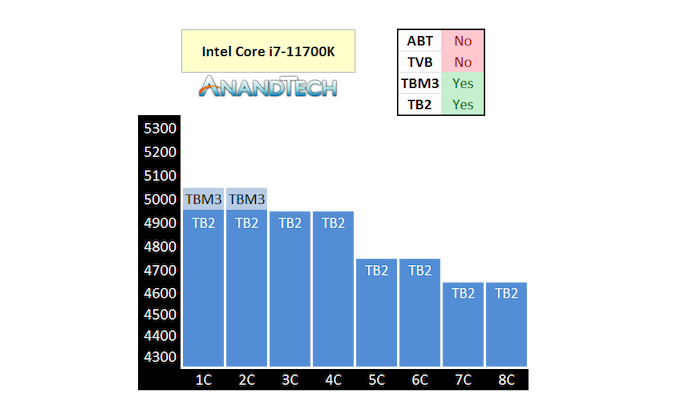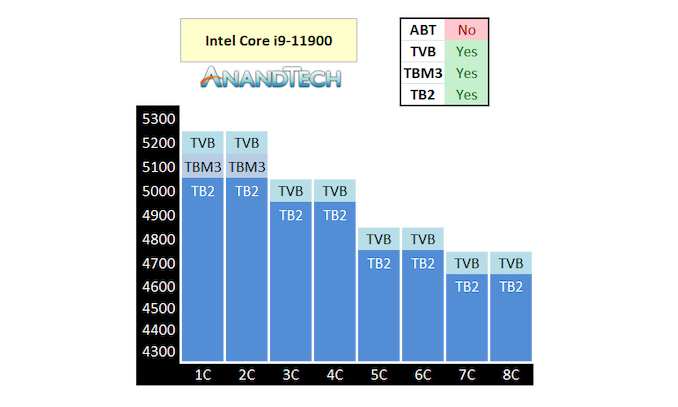Intel Rocket Lake (14nm) Review: Core i9-11900K, Core i7-11700K, and Core i5-11600K
by Dr. Ian Cutress on March 30, 2021 10:03 AM EST- Posted in
- CPUs
- Intel
- LGA1200
- 11th Gen
- Rocket Lake
- Z590
- B560
- Core i9-11900K
Intel’s New Adaptive Boost Technology for Core i9-K/KF
Taken from our news item
To say that Intel’s turbo levels are complicated to understand is somewhat of an understatement. Trying to teach the difference between the turbo levels to those new to measuring processor performance is an art form in of itself. But here’s our handy guide, taken from our article on the subject.
Adaptive Boost Technology is now the fifth frequency metric Intel uses on its high-end enthusiast grade processors, and another element in Intel’s ever complex ‘Turbo’ family of features. Here’s the list, in case we forget one:
| Intel Frequency Levels | ||
| Base Frequency | - | The frequency at which the processor is guaranteed to run under warranty conditions with a power consumption no higher than the TDP rating of the processor. |
| Turbo Boost 2.0 | TB2 | When in a turbo mode, this is the defined frequency the cores will run at. TB2 varies with how many cores are being used. |
| Turbo Boost Max 3.0 | TBM3 'Favored Core' |
When in a turbo mode, for the best cores on the processor (usually one or two), these will get extra frequency when they are the only cores in use. |
| Thermally Velocity Boost | TVB | When in a turbo mode, if the peak thermal temperature detected on the processor is below a given value (70ºC on desktops), then the whole processor will get a frequency boost of +100 MHz. This follows the TB2 frequency tables depending on core loading. |
| Adaptive Boost Technology | ABT 'floating turbo' |
When in a turbo mode, if 3 or more cores are active, the processor will attempt to provide the best frequency within the power budget, regardless of the TB2 frequency table. The limit of this frequency is given by TB2 in 2-core mode. ABT overrides TVB when 3 or more cores are active. |
| *Turbo mode is limited by the turbo power level (PL2) and timing (Tau) of the system. Intel offers recommended guidelines for this, but those guidelines can be overridden (and are routinely ignored) by motherboard manufacturers. Most gaming motherboards will implement an effective ‘infinite’ turbo mode. In this mode, the peak power observed will be the PL2 value. It is worth noting that the 70ºC requirement for TVB is also often ignored, and TVB will be applied whatever the temperature. | ||
Intel provided a slide trying to describe the new ABT, however the diagram is a bit of a mess and doesn’t explain it that well. Here’s the handy AnandTech version.
First up is the Core i7-11700K that AnandTech has already reviewed. This processor has TB2, TBM3, but not TVB or ABT.
The official specifications show that when one to four cores are loaded, when in turbo mode, it will boost to 4.9 GHz. If it is under two cores, the OS will shift the threads onto the favored cores and Turbo Boost Max 3.0 will kick in for 5.0 GHz. More than four core loading will be distributed as above.
On the Core i9-11900, the non-overclocking version, we also get Thermal Velocity Boost which adds another +100 MHz onto every core max turbo, but only if the processor is below 70ºC.
We can see here that the first two cores get both TBM3 (favored core) as well as TVB, which makes those two cores give a bigger jump. In this case, if all eight cores are loaded, the turbo is 4.6 GHz, unless the CPU is under 70ºC, then we get an all-core turbo of 4.7 GHz.
Now move up to the Core i9-11900K or Core i9-11900KF, which are the only two processors with the new floating turbo / Adaptive Boost Technology. Everything beyond two cores changes and TVB no longer applies.
Here we see what looks like a 5.1 GHz all-core turbo, from three cores to eight cores loaded. This is +300 MHz above TVB when all eight cores are loaded. But the reason why I’m calling this a floating turbo is because it is opportunistic.
What this means is that, if all 8 cores are loaded, TB2 means that it will run at 4.7 GHz. If there is power budget and thermal budget, it will attempt 4.8 GHz. If there is more power budget and thermal budget available, it will go to 4.9 GHz, then 5.0 GHz, then 5.1 GHz. The frequency will float as long as it has enough of those budgets to play with, and it will increase/decrease as necessary. This is important as different instructions cause different amounts of power draw and such.
If this sounds familiar, you are not wrong. AMD does the same thing, and they call it Precision Boost 2, and it was introduced in April 2018 with Zen+. AMD applies its floating turbo to all of its processors – Intel is currently limiting floating turbo to only the Core i9-K and Core i9-KF in Core 11th Gen Rocket Lake.
One of the things that we noticed with AMD however is that this floating turbo does increase power draw, especially with AVX/AVX2 workloads. Intel is likely going to see similar increases in power draw. What might be a small saving grace here is that Intel’s frequency jumps are still limited to full 100 MHz steps, whereas AMD can do it on the 25 MHz boundary. This means that Intel has to manage larger steps, and will likely only cross that boundary if it knows it can be maintained for a fixed amount of time. It will be interesting to see if Intel gives the user the ability to change those entry/exit points for Adaptive Boost Technology.
There will be some users who are already familiar with Multi-Core Enhancement / Multi-Core Turbo. This is a feature from some motherboard vendors have, and often enable at default, which lets a processor reach an all-core turbo equal to the single core turbo. That is somewhat similar to ABT, but that was more of a fixed frequency, whereas ABT is a floating turbo design. That being said, some motherboard vendors might still have Multi-Core Enhancement as part of their design anyway, bypassing ABT.
Overall, it’s a performance plus. It makes sense for the users that can also manage the thermals. AMD caught a wind with the feature when it moved to TSMC’s 7nm. I have a feeling that Intel will have to shift to a new manufacturing node to get the best out of ABT, and then we might see the feature on the more mainstream CPUs, as well as becoming default as standard.













279 Comments
View All Comments
SystemsBuilder - Wednesday, March 31, 2021 - link
and you are a Computer Science graduate? What Linus T. is saying is that AVX-512 is a power hog and he is right about that. Linus T. is not saying that "a couple dozen or so people" are able to program it. Power requirements and programing hardness are 2 different things.On the second point, I 100% stand by that any decent Computer Science/Engineering graduate should be able to program AVX-512 effectively (overcoming hardness not power requirements).
Also, I do program AVX-512 and I 100% stand by what I said. You just need to know what you are doing and vectorize algorithms. If you use the good old sequential algorithms you will not archive anything with AVX-512, but it you vectorize you're classical algorithms you will also achieve >100% benefits in many inner loops in so called mainstream programming. AVX-512 can give you 2x uplift if you know how to utilize both FMA units on port 0+1 and 5 and it's not hard.
Lastly, with decent negative AVX-512 offsets in BIOS, you can bring down the power utilization to ok levels AND still get 2x improvements in the inner loops (because of vectorized algorithmic improvement).
Hifihedgehog - Wednesday, March 31, 2021 - link
> and you are a Computer Science graduate?No, I am a Computer Engineering graduate. Sorry, but you are grasping at straws. Plus you are overcomplicating the obvious to try to be an Intel apologist. Just see this and this. Read it and weep. Intel flopped big time this release:
https://i.imgur.com/HZVC03T.png
https://i.imgflip.com/53vqce.jpg
SystemsBuilder - Wednesday, March 31, 2021 - link
So fellow CS/CE grad. I'm not arguing that AVX-512 is a power hog (it is) or that the AVX-512 offsets slows down the rest of the CPU (they do). I am arguing the premise that AVX-512 is supposed to be so incredibly hard to do that only "couple dozen or so people" can do is wrong today - Skylake-X with AVX-512 was launched 2017 for heaven's sake. Surely, I can't be the only CS/CE guy how figured it out by now. I mean really? When Ian wrote what Keller said (and keep on writing it) that that this AVX-512 is sooo hard to do that only a few guys on the planet can do it well, my reaction was "let's see about that". I mean come on guys, really!SystemsBuilder - Wednesday, March 31, 2021 - link
More specifically Linus is concerned that because you need to use negative offsets to keep the power utilization down when engaging AVX-512 it slows down everything else going on. i.e. AVX-512 power requirements overall CPU impact. The new cores designs (already Cypress Cove maybe? but Sapphire Rapids definitely!) will allow AVX-512 workloads to run at one frequency (with lower negative offsets that for instance Skylake-X) and non AVX-512 workloads at a different frequency on various cores and keep within the power budget. this is ideal.arashi - Wednesday, March 31, 2021 - link
This belongs in r/ConfidentlyIncorrect and r/IAmVerySmart, anyone who thinks coding for AVX512 PROPERLY is doable by "any CS/CE major graduate worth their salt" would be laughed out of the industry.Hifihedgehog - Wednesday, March 31, 2021 - link
Exactly. The real reason for the nonsensical wall of text is SystemsBuilder is trying desperately to overexplain things to put lipstick on a pig. And he repeats himself too like I am listening to an automated bot caught in a recursive loop which is quite funny actually.SystemsBuilder - Wednesday, March 31, 2021 - link
So you are a CE major, have you actually tried to program in AVX 512? If not, try to do a matrix by matrix multiplication of 16x16 FP32 matrices for instance and come back. You'll notice incredible performed increase. It's not lipstick on a pig, it actually is very powerful, especially computing through large volumes of related data SIMD style.Meteor2 - Saturday, April 17, 2021 - link
Disappointing response. You throw insults but not rebuttals.Me thinks SB has a point.
SystemsBuilder - Wednesday, March 31, 2021 - link
really? any you are one CS graduate? have you tried?MS - Tuesday, March 30, 2021 - link
What the he'll is that supposed to mean that you can't you can't get the frequency at 10 nm and therefore you have to stick with the 14 nm node? That's pure nonsense, AND is at 7 nm and they are getting the target frequencies. Maybe stop spreading the Coolaid and call a spade a spade....